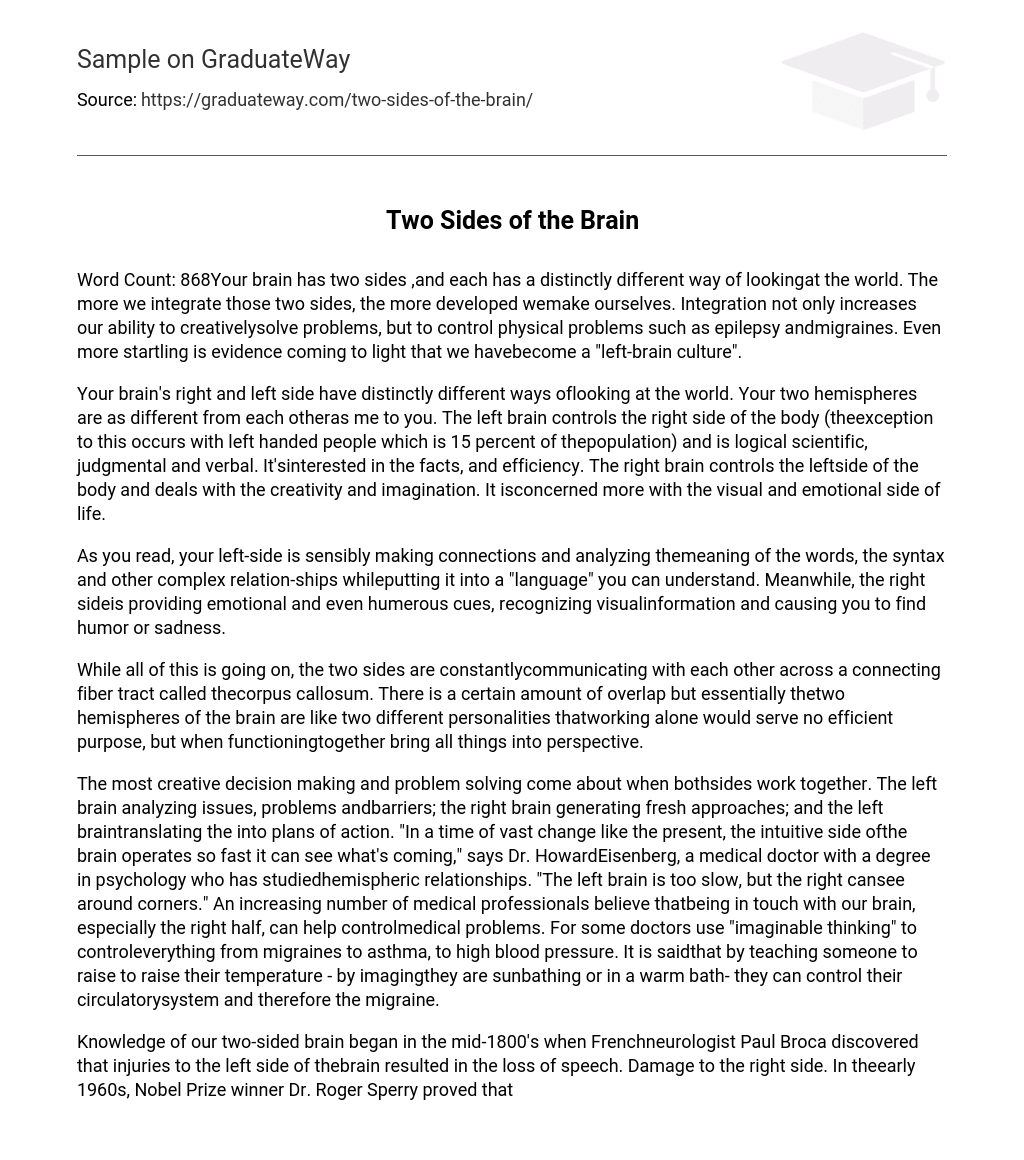Your brain has two sides ,and each has a distinctly different way of looking at the world. The more we integrate those two sides, the more developed we make ourselves. Integration not only increases our ability to creatively solve problems, but to control physical problems such as epilepsy and migraines. Even more startling is evidence coming to light that we have become a “left-brain culture”.
Your brain’s right and left side have distinctly different ways of looking at the world. Your two hemispheres are as different from each other as me to you. The left brain controls the right side of the body (the perception to this occurs with left-handed people which is 15 percent of the population) and is logical scientific, judgmental and verbal. Disinterested in the facts, and efficiency. The right brain controls the leftside of the body and deals with creativity and imagination. It is concerned more with the visual and emotional side of life.
As you read, your left-side is sensibly making connections and analyzing the meaning of the words, the syntax and other complex relationships while putting it into a “language” you can understand. Meanwhile, the right sideis provides emotional and even humerous cues, recognizing visual information and causing you to find humor or sadness.
While all of this is going on, the two sides are constantly communicating with each other across a connecting fiber tract called thecorpus callosum. There is a certain amount of overlap but essentially thetwo hemispheres of the brain are like two different personalities thatworking alone would serve no efficient purpose, but when functioning together bring all things into perspective.
The most creative decision-making and problem-solving come about when both sides work together. The left brain analyzing issues, problems and barriers; the right brain generating fresh approaches; and the left brain translates the into plans of action. “In a time of vast change like the present, the intuitive side of the brain operates so fast it can see what’s coming,” says Dr. HowardEisenberg, a medical doctor with a degree in psychology who has studied hemispheric relationships. “The left brain is too slow, but the right can see around corners.” An increasing number of medical professionals believe that being in touch with our brain, especially the right half, can help control medical problems. For some doctors use “imaginable thinking” to control everything from migraines to asthma, to high blood pressure. It is said that by teaching someone to raise to raise their temperature – by imagine they are sunbathing or in a warm bath- they can control their circulatory system and therefore the migraine.
Knowledge of our two-sided brain began in the mid-1800’s when French neurologist Paul Broca discovered that injuries to the left side of the brain resulted in the loss of speech. Damage to the right side. In the early 1960s, Nobel Prize winner Dr. Roger Sperry proved that patients who had their corpus callosum severed to try and control epileptic seizures could no longer communicate between their hemispheres. The struggle can beseen in the postoperative period when the patient is asked to do a simple block design. This is a visual, spatial task that the left-hand (controlled by the right brain in most of us) can do very well but the right hand(controlled by the language-oriented left brain) does poorly. The righthand may even intervene to mix up the design.
Some people with epilepsy can control their seizures by concentrating activity on the hemisphere that is not affected. In the case of left lobe epilepsy, this can be done by nagging in a right-brain activity such as drawing.
Our knowledge of the brain is general is only beginning. We know even less about how the hemispheres operate, Getting in touch with how the two sides work can only do us good, if just to keep us from walking around”half-brained”.
DiagramsParietal FrontalOccipital TemporalParietalLocated behind the frontal lobe and behind and above the temporal lobe,the parietal lobe plays a major role in sensory functioning – for example, spatial orientation and integrating sensory information. Reading, writing,and the performance of mental calculations also depend on the parietal lobe.
OccipitalThe occipital lobe, which occupies the rear of each hemisphere,receives and assembles visual information. Damage to the occipital lobe can cause a “blind spot” in one’s vision. The size and location of the blindspot are related to the location and extent of the damageFrontalThe large frontal lobe extends from the forehead back to the middle of the skull. It handles numerous high-order cognitive functions, including planning, organization, judgment, decision making, social graces, and inhibition of impulses. It is also the centre of voluntry speech andmovementTemporalThe temporal lobe is located to the side of and below the frontal lobe(behind the temple). It is responsible for learning and memory as well as auditory perception (hearing), comprehension of spoken language, and perception of musical characteristics such as rhythm and pitch.





